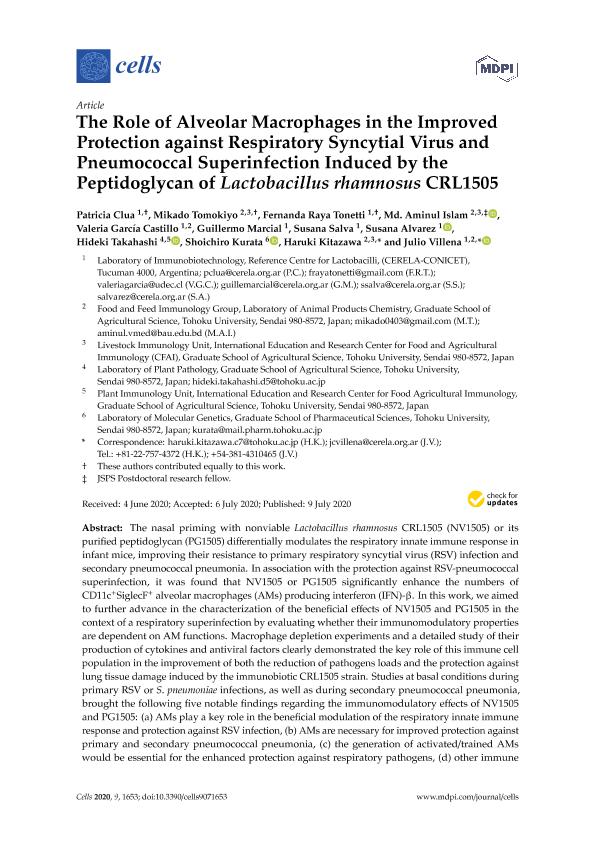Artículo
The Role of Alveolar Macrophages in the Improved Protection against Respiratory Syncytial Virus and Pneumococcal Superinfection Induced by the Peptidoglycan of Lactobacillus rhamnosus CRL1505
Clua, Maria Patricia ; Tomokiyo, Mikado; Raya Tonetti, María Fernanda
; Tomokiyo, Mikado; Raya Tonetti, María Fernanda ; Islam, Md Aminul; García Castillo, Valeria; Marcial, Guillermo Emilio
; Islam, Md Aminul; García Castillo, Valeria; Marcial, Guillermo Emilio ; Salva, Maria Susana
; Salva, Maria Susana ; Alvarez, Susana; Takahashi, Hideki; Kurata, Shoichiro; Kitazawa, Haruki; Villena, Julio Cesar
; Alvarez, Susana; Takahashi, Hideki; Kurata, Shoichiro; Kitazawa, Haruki; Villena, Julio Cesar
 ; Tomokiyo, Mikado; Raya Tonetti, María Fernanda
; Tomokiyo, Mikado; Raya Tonetti, María Fernanda ; Islam, Md Aminul; García Castillo, Valeria; Marcial, Guillermo Emilio
; Islam, Md Aminul; García Castillo, Valeria; Marcial, Guillermo Emilio ; Salva, Maria Susana
; Salva, Maria Susana ; Alvarez, Susana; Takahashi, Hideki; Kurata, Shoichiro; Kitazawa, Haruki; Villena, Julio Cesar
; Alvarez, Susana; Takahashi, Hideki; Kurata, Shoichiro; Kitazawa, Haruki; Villena, Julio Cesar
Fecha de publicación:
07/2020
Editorial:
Multidisciplinary Digital Publishing Institute
Revista:
Cells
e-ISSN:
2073-4409
Idioma:
Inglés
Tipo de recurso:
Artículo publicado
Clasificación temática:
Resumen
The nasal priming with nonviable Lactobacillus rhamnosus CRL1505 (NV1505) or its purified peptidoglycan (PG1505) differentially modulates the respiratory innate immune response in infant mice, improving their resistance to primary respiratory syncytial virus (RSV) infection and secondary pneumococcal pneumonia. In association with the protection against RSV-pneumococcal superinfection, it was found that NV1505 or PG1505 significantly enhance the numbers of CD11c+SiglecF+ alveolar macrophages (AMs) producing interferon (IFN)-β. In this work, we aimed to further advance in the characterization of the beneficial effects of NV1505 and PG1505 in the context of a respiratory superinfection by evaluating whether their immunomodulatory properties are dependent on AM functions. Macrophage depletion experiments and a detailed study of their production of cytokines and antiviral factors clearly demonstrated the key role of this immune cell population in the improvement of both the reduction of pathogens loads and the protection against lung tissue damage induced by the immunobiotic CRL1505 strain. Studies at basal conditions during primary RSV or S. pneumoniae infections, as well as during secondary pneumococcal pneumonia, brought the following five notable findings regarding the immunomodulatory effects of NV1505 and PG1505: (a) AMs play a key role in the beneficial modulation of the respiratory innate immune response and protection against RSV infection, (b) AMs are necessary for improved protection against primary and secondary pneumococcal pneumonia, (c) the generation of activated/trained AMs would be essential for the enhanced protection against respiratory pathogens, (d) other immune and nonimmune cell populations in the respiratory tract may contribute to the protection against bacterial and viral infections, and (e) the immunomodulatory properties of NV1505 and PG1505 are strain-specific. These findings significantly improve our knowledge about the immunological mechanisms involved in the modulation of respiratory immunity induced by beneficial microbes.
Archivos asociados
Licencia
Identificadores
Colecciones
Articulos(INSIBIO)
Articulos de INST.SUP.DE INVEST.BIOLOGICAS
Articulos de INST.SUP.DE INVEST.BIOLOGICAS
Citación
Clua, Maria Patricia; Tomokiyo, Mikado; Raya Tonetti, María Fernanda; Islam, Md Aminul; García Castillo, Valeria; et al.; The Role of Alveolar Macrophages in the Improved Protection against Respiratory Syncytial Virus and Pneumococcal Superinfection Induced by the Peptidoglycan of Lactobacillus rhamnosus CRL1505; Multidisciplinary Digital Publishing Institute; Cells; 9; 7; 7-2020; 1-27
Compartir
Altmétricas



